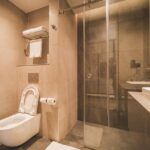
This is the world of Healthcare Facility Cleaning, where hygiene is more than just a routine; it is a commitment to creating a healing environment where risks are minimized. We will walk you through the basic yet essential elements of upholding stringent hygiene standards in healthcare settings. Picture a place where every surface, from the operating rooms to the waiting rooms, plays a vital role in keeping patients safe and healthy.
Cleaning is not an option; it is a necessity in the healthcare industry. The health of patients, staff members, and guests is directly linked to every aspect of a healthcare facility, from the hygienic state of patient rooms to the meticulous standards demanded in surgical suites. This guide will walk you through the key components that make cleaning a healthcare facility more than just a chore, but rather a vital component of meeting and exceeding the stringent hygiene standards established to safeguard those entrusting their well-being to these areas.
Let us dive into the core of healthcare facility cleaning, where necessity meets simplicity and every wiped surface contributes to everyone’s safety and well-being. As we proceed through the sections that follow, we will discuss the significance of common areas and waiting rooms, the meticulous cleaning protocols in surgical suites, the importance of cleaning in patient areas, the upkeep of staff and administrative areas, and the growing emphasis on environmental sustainability in healthcare cleaning.
See also our post on Tips for Cleaning Medical Equipment: Ensuring Sterility in Healthcare Facilities
The Critical Role of Cleanliness in Healthcare
In the healthcare landscape, cleanliness is not a luxury; it’s a fundamental pillar. The stakes are high, and every surface, from the reception desk to the patient rooms, plays a crucial role in preventing infections and ensuring a safe environment for both patients and healthcare professionals.
1. Patient Safety
Clean healthcare facilities are synonymous with patient safety. Rigorous cleaning practices help prevent the spread of infections, ensuring that patients receive care in an environment that minimizes health risks.
2. Infection Control
Infection control is at the forefront of healthcare cleaning. Thorough cleaning and disinfection protocols are implemented to reduce the risk of healthcare-associated infections, safeguarding vulnerable patients from additional health complications.
3. Regulatory Compliance
Healthcare facilities operate under strict regulations. Meeting and exceeding cleanliness standards is not just a best practice but a legal requirement. Compliance ensures that facilities maintain the highest standards of hygiene as mandated by health authorities.
4. Staff and Visitor Well-being
Cleanliness extends beyond patient care; it also impacts the well-being of healthcare staff and visitors. A clean environment promotes a positive atmosphere, contributing to the overall experience and comfort of everyone within the healthcare facility.
5. Reputation and Trust
The cleanliness of a healthcare facility is intertwined with its reputation. Patients place immense trust in healthcare providers, and a clean environment reinforces that trust. A facility known for its commitment to cleanliness builds a positive reputation within the community.
Cleaning Protocols in Patient Areas
Bedside Cleaning
Patient rooms require meticulous cleaning, with a focus on bedside surfaces, bedrails, and frequently touched items. Regular cleaning and disinfection contribute to a safe and comfortable space for patients.
Medical Equipment Cleaning
Thorough cleaning of medical equipment is paramount. From blood pressure cuffs to stethoscopes, ensuring that all equipment is cleaned according to protocols prevents the risk of cross-contamination and infections.
High-Touch Surfaces
High-touch surfaces, such as doorknobs, light switches, and remote controls, are breeding grounds for germs. Rigorous cleaning of these surfaces is crucial to prevent the spread of infections among patients and staff.
Bathroom Sanitization
Patient bathrooms demand meticulous attention. Regular sanitization of toilet surfaces, sinks, and handles is essential to maintain a hygienic environment and prevent the transmission of infections.
Linen and Bedding Care
Proper handling and cleaning of linens and bedding are essential components of healthcare cleaning. Following stringent laundry protocols ensures that patients rest in a clean and comfortable environment.
See also our post on 10 Benefits of Utilizing Professional Cleaning Services for Theater Productions
Surgical Suite and Operating Room Cleaning
Preoperative Cleaning
Preoperative cleaning is a meticulous process that prepares the surgical suite for procedures. Thorough cleaning of surfaces, equipment, and ensuring sterile conditions are essential to prevent surgical site infections.
Operating Room Sterilization
Operating rooms require aseptic conditions. Sterilization of surgical instruments, surfaces, and maintaining a dust-free environment are critical steps to ensure the success of surgical procedures and patient safety.
Postoperative Cleaning
Postoperative cleaning involves the removal of any biological materials and the disinfection of surfaces. This step is crucial in preventing infections and creating a clean environment for the next surgical procedure.
Equipment Disinfection
Surgical instruments and equipment undergo rigorous disinfection processes. Following manufacturer guidelines and industry standards ensures that equipment is free from contaminants and safe for use in medical procedures.
Air Quality Control
Controlling air quality in operating rooms is vital. The circulation and filtration of air prevent the accumulation of airborne contaminants, contributing to a sterile and safe environment for surgical interventions.
Common Areas and Waiting Rooms
Reception and Waiting Areas
Cleanliness in reception and waiting areas is the first impression patients and visitors receive. Regular cleaning of these spaces includes disinfecting surfaces, cleaning furniture, and ensuring a welcoming atmosphere.
Floor Maintenance
High-traffic areas demand regular floor maintenance. From sweeping and mopping to addressing spills promptly, maintaining clean floors enhances the overall cleanliness and safety of common areas.
Trash Management
Efficient trash management is crucial in common areas. Regularly emptying bins, segregating waste, and following proper disposal procedures contribute to a clean and hygienic environment.
Magazine and Literature Displays
Reading materials in waiting areas are high-touch items. Regular cleaning and rotation of magazines and literature prevent the accumulation of germs and contribute to a tidy and welcoming atmosphere.
Children’s Play Areas
Healthcare facilities catering to pediatric patients often have play areas. Regular cleaning and disinfection of toys, surfaces, and play equipment ensure a safe and germ-free environment for young patients.
Laboratory and Diagnostic Areas
Equipment Calibration and Cleaning
Laboratory equipment requires precise calibration and regular cleaning. Following manufacturer guidelines and industry standards ensures the accuracy of diagnostic results and prevents cross-contamination.
Sample Handling and Storage
Proper handling and storage of samples are crucial in diagnostic areas. Implementing a systematic approach to sample management, including labeling and refrigeration, prevents errors and maintains sample integrity.
Disposal of Hazardous Materials
Diagnostic areas often deal with hazardous materials. Proper disposal of these materials, following safety protocols, ensures the protection of healthcare staff, patients, and the environment.
Surface Decontamination
Regular decontamination of surfaces in laboratory settings prevents the spread of contaminants. Cleaning workbenches, countertops, and other surfaces contributes to a sterile environment for diagnostic procedures.
Quality Control in Equipment
Quality control measures in diagnostic equipment maintenance are essential. Regular checks, calibration, and adherence to quality control protocols guarantee the accuracy and reliability of diagnostic results.
Staff and Administrative Spaces
Employee Workstations
Clean workstations contribute to the overall well-being of healthcare staff. Encouraging employees to maintain organized and clean workspaces creates a positive and efficient work environment.
Administrative Areas
Administrative areas require regular cleaning to ensure a professional and organized workspace. From desks and filing cabinets to shared spaces, cleanliness contributes to a conducive atmosphere for administrative tasks.
Breakroom and Kitchen Cleaning
Clean breakrooms and kitchens are essential for the health and well-being of healthcare staff. Regular cleaning of appliances, surfaces, and utensils promotes a hygienic environment for meal preparation and relaxation.
Restroom Sanitization
Staff restrooms demand the same level of attention as patient restrooms. Thorough cleaning and disinfection of restroom surfaces contribute to the overall cleanliness of healthcare facilities.
Employee Training on Hygiene
Employee training on hygiene practices is crucial. Educating staff on the importance of cleanliness, adherence to protocols, and their role in maintaining a clean healthcare facility fosters a culture of responsibility.
Environmental Sustainability in Healthcare Cleaning
Eco-Friendly Cleaning Products
Adopting eco-friendly cleaning products contributes to environmental sustainability. These products are less harmful to the environment and align with healthcare facilities’ commitment to responsible practices.
Waste Reduction and Recycling
Healthcare facilities can implement waste reduction and recycling initiatives. Proper waste segregation, recycling of materials, and responsible disposal contribute to sustainable and environmentally friendly practices.
Energy-Efficient Cleaning Practices
Healthcare cleaning can embrace energy-efficient practices. This may involve using energy-efficient cleaning equipment, contributing to reduced energy consumption and a smaller carbon footprint.
Green Certifications and Practices
Healthcare facilities can seek green certifications or practices for their cleaning operations. These certifications indicate a commitment to environmentally friendly cleaning methods and adherence to established sustainability standards.
Collaboration for Sustainable Practices
Healthcare facilities can collaborate with cleaning services to implement sustainable practices. This may include jointly developing initiatives to reduce waste, conserve energy, and promote overall environmental responsibility.
See also our post on How to Clean Your Home Gym: Hygiene for a Healthier Workout
Conclusion
The meticulous world of healthcare facility cleaning is not just about tidying up; it’s a commitment to patient safety, infection control, and the overall well-being of everyone within the healthcare setting. From patient areas to surgical suites, common spaces to administrative offices, each aspect of cleanliness plays a vital role in meeting strict hygiene standards. Healthcare professionals, cleaning staff, and administrators all contribute to the intricate dance of maintaining a safe and clean environment. In the pursuit of excellence, healthcare facilities demonstrate that cleanliness isn’t just a routine; it’s a lifeline that ensures the trust and well-being of those who entrust their health to these vital spaces. Through unwavering dedication to cleanliness, healthcare facilities become beacons of safety, comfort, and care.






